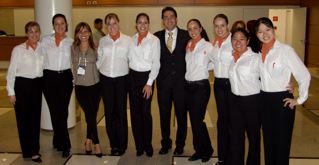In my previous post, I made the case for (and against) talent speedreading, the art of quickly identifying other people's talents and strengths, as well as weaknesses. Now, let's proceed to the practical part: how to do it.
First of all, you need to define a vocabulary, a taxonomy or some sort of theory about talents. The Clifton StrengthsFinder is an obvious choice for talent speadreading, but it is not the only one.
For example, Paul D. Tieger and Barbara Barron-Tieger wrote a book with the title "The Art of SpeedReading People" which also inspired me to write this post. Their system is based on the Myers-Briggs Type Indicator (MBTI), an inventory of personality type which has its roots in the theories of the Swiss psychologist Carl Gustav Jung.
As I outlined elsewhere in this blog, the study of personality (both the theories about it and your own personality) is most helpful in understanding your strengths and weaknesses. Therefore, the MBTI and the Tiegers' book provide many helpful insights into identifying talents.
In this post, I propose to work with the 34 talent themes of the Clifton StrengthsFinder.
Next, you should develop a thorough understanding of these 34 talent themes. You should know them inside out. Books like "Strengths-Based Leadership" or "Discovering Your Sales Strengths" provide important insights and examples.
But even if you have a very good but theoretical understanding of these 34 themes, it may be difficult to properly identify them in the "heat of the battle" of a typical working day. Some talents can be confusingly similar, like Strategic and Deliberative, Intellection and Connectedness, Woo and Positivity, Relator and Individualization, Command and Self-Assurance, Adaptability and Arranger.
Therefore, I would like to propose a "shortcut" based on the four leadership domains presented in Gallup's new book "Strengths-Based Leadership":
Executing:
ACHIEVER, ARRANGER, BELIEF, CONSISTENCY, DELIBERATIVE, DISCIPLINE, FOCUS, RESPONSIBILITY, RESTORATIVE.
Influencing:
ACTIVATOR, COMMAND, COMMUNICATION, COMPETITION, MAXIMIZER, SELF-ASSURANCE, SIGNIFICANCE, WOO
Relationship Building
ADAPTABILITY, DEVELOPER, CONNECTEDNESS, EMPATHY, HARMONY, INCLUDER, INDIVIDUALIZATION, POSITIVITY, RELATOR.
Strategic Thinking:
ANALYTICAL, CONTEXT, FUTURISTIC, IDEATION, INPUT, INTELLECTION, LEARNER, STRATEGIC.
I have found these four domains very useful not only for quickly assessing the relative strengths and weaknesses of a team but also those of individuals. And it helps to avoid to fall into some common pitfalls, such as confusing the strength of "Relationship Building" with the strength of "Influencing", or confusing the strengths of "Strategic Thinking" (and "Talking") with "Execution".
I confess that I myself often confused these domains which led me to be surprised when meeting very friendly salespeople (Relationship Building) who had difficulties in closing sales (Influencing), or when meeting rather tough if not arrogant people (Influencing) who were then presented to me as very successful sales people.
And people who excel in Strategic Thinking can leave a great impression but do not necessarily get a lot done later on (Execution). On the other side, execution strength is of questionable value if the wrong things get executed in terms of strategy or ethics (the current economic crisis provides ample evidence of this). Also, I have seen effective employees (but weak in Strategic Thinking) going through some embarassment when being exposed to a senior management meeting deliberating strategies. The business literature is full of examples and discussions about this phenomenon. Read Ram Charan's book "Execution" or Jack Welch's "Winning" for example.
There are other ways of clustering the 34 talent themes which can also provide important clues to speedreading talents. Gallup itself used a slightly different version of the four domains in the past. Have a look a this interesting page on the Clifton StrengthsFinder Blog.
On that same blog, by the way, you can find an interesting list of short paragraphs for each talent, like "Significance-loves to make a difference" or "Command-loves to make their own decisions". Memorize these 34 paragraphs and they will come to your mind when you see them in the behaviour of the people you try to speedread. Yes, you have to memorize these things, in the same way people used to learn by heart Shakespeare quotes or Bible verses in the past. TalentSpeedreading requires quite an effort, it is not just a quick fix.
So enough about theory, let's move on! Let's say you conclude that a person has many talents in Relationship Building and Execution, but not in Influencing and Strategic Thinking. So what's next?
Well first of all, let's appreciate that with this information alone, we know quite a lot already, at least for the workplace environment.
But you can drill down deeper from here and try to figure out which talents might be behind this person's strength in Relationship Building: Empathy, Includer, Relator?
Thinking in terms of the four domains also makes it easier to distinguish between "similar" talents like Positivity (Relationship Building) and Woo (Influencing). If you are not sure whether someone has Positivity or Woo, but feel that he is much better at Relationship Building than at Influencing, then you want to bet on Positivity. The same logic applies to:
- Deliberative (Executing) and Strategic (Strategic Thinking),
- Connetctedness (Relationship Building) and Intellection (Strategic Thinking),
- Adaptability (Relationship Building) and Arranger (Executing), and again:
- Positivity (Relationship Building) and Woo (Influencing)
So you observe people. You talk with the peers of the people you observe. And of course, you speak with the people whose talents you want to identify. However, you want to focus more on actual behavior than words.
A simple approach of doing this is to ask simple questions like "Tell me about what you really enjoy doing at work" or "Tell me what you do best" or "Tell me about your biggest success story" and so on. Again, there might be a risk that the answers to these questions are "manipulated" to be socially desirable, especially if you are a manager talking to an employee, and even more so if either one of you is new on the job. In order to get a feeling whether these answers are real or "faked", you should ask for specific details, like "tell me about a time when...". You may want to read my post about Behaviour-Interviewing for Strengths for more on this.
At last, let me say that I realize that all these suggestions are just shortcuts based on enormeous simplifcations. This is always dangerous when dealing with something as complex as human nature and talents. But I believe that this does not mean that we should not try. Dr. Jerome Groopman, author of the excellent book "How Doctors Think" writes something very interesting about the importance of shortcuts in another very complex field: medicine (p. 35 f.):
"Reasearch shows that most doctors come up with two or three diagnoses from the outset of meeting a patient - a few talented ones can juggle four or five in their minds. All develop their hypotheses from a very incomplete body of information. To do this, doctors use shortcuts. These are called heuristics.
... Shortcuts are the doctor's response to uncertainty and demands of the situation. They are the essential working tools of clinical medicine, where a doctor must combine thought and action.
... The problem is that medical schools do not teach shortcuts. In fact, you are discouraged from using them...
... Of course, a doctor must know physiology and pathology and pharmacology. But he should also be schooled in heuristics - in the power and necessity of using shortcuts, and in their pitfalls and dangers."
When reading this, I feel tempted to exchange "doctors" with "managers", "medicine" with "management", "patients" with "employees" or "colleagues", "medical school" with "business school" or "textbooks".
Thus, I hope that this post may help some fellow managers to develop some vital "shortcuts" in the area of strengths-based leadership!







0 comments:
Post a Comment